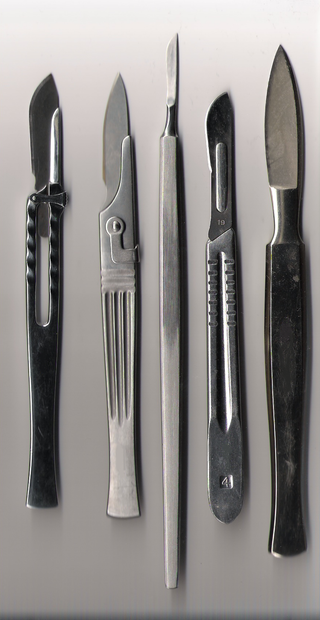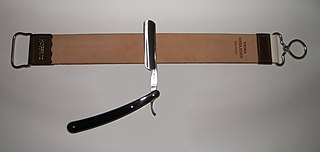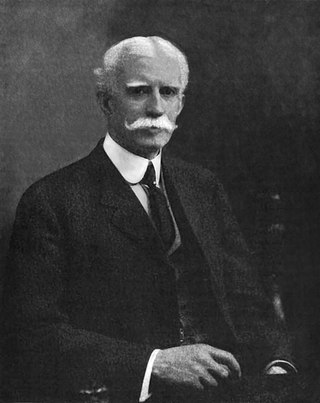
Shaving is the removal of hair, by using a razor or any other kind of bladed implement, to slice it down—to the level of the skin or otherwise. Shaving is most commonly practiced by men to remove their facial hair and by women to remove their leg and underarm hair. A man is called clean-shaven if he has had his beard entirely removed.

King Camp Gillette was an American businessman who invented a bestselling safety razor. Gillette's innovation was the thin, inexpensive, disposable blade of stamped steel. Gillette is often erroneously credited with inventing the so-called razor and blades business model in which razors are sold cheaply to increase the market for blades. However, Gillette Safety Razor Company adopted the business model from its competitors.

A scalpel, lancet, or bistoury is a small and extremely sharp bladed instrument used for surgery, anatomical dissection, podiatry and various arts and crafts. Scalpels may be single-use disposable or re-usable. Re-usable scalpels can have permanently attached blades that can be sharpened or, more commonly, removable single-use blades. Disposable scalpels usually have a plastic handle with an extensible blade and are used once, then the entire instrument is discarded. Scalpel blades are usually individually packed in sterile pouches but are also offered non-sterile. Double-edged scalpels are referred to as "lancets".

A razor is a bladed tool primarily used in the removal of body hair through the act of shaving. Kinds of razors include straight razors, safety razors, disposable razors, and electric razors.
Gillette is an American brand of safety razors and other personal care products including shaving supplies, owned by the multi-national corporation Procter & Gamble (P&G). Based in Boston, Massachusetts, United States, it was owned by The Gillette Company, a supplier of products under various brands until that company merged into P&G in 2005. The Gillette Company was founded by King C. Gillette in 1901 as a safety razor manufacturer.

A razor strop or simply a strop is a flexible strip of leather, canvas, denim fabric, balsa wood, or other soft material, used to straighten and polish the blade of a straight razor, a knife, or a woodworking tool such as a chisel. In many cases stropping re-aligns parts of the blade edge that have been bent out of alignment. In other cases, especially when abrasive polishing compound is used, stropping may remove a small amount of metal. Stropping can also burnish the blade.

An electric shaver is a razor with an electrically powered rotating or oscillating blade. The electric shaver usually does not require the use of shaving cream, soap, or water. The razor may be powered by a small DC motor, which is either powered by batteries or mains electricity. Many modern ones are powered using rechargeable batteries. Alternatively, an electro-mechanical oscillator driven by an AC-energized solenoid may be used. Some very early mechanical shavers had no electric motor and had to be powered by hand, for example by pulling a cord to drive a flywheel.

Wilkinson Sword is a formerly British brand for razors and other personal care products sold in Europe, owned by the US company Edgewell Personal Care. The company was founded as a manufacturer of guns made in Shotley Bridge in County Durham, by Henry Nock in London in 1772.

A straight razor is a razor with a blade that can fold into its handle. They are also called open razors and cut-throat razors. The predecessors of the modern straight razors include bronze razors, with cutting edges and fixed handles, produced by craftsmen from Ancient Egypt during the New Kingdom. Solid gold and copper razors were also found in Ancient Egyptian tombs dating back to the 4th millennium BC.

Schick is an American brand of personal care products and safety razors which was founded in 1926 by Jacob Schick. It is currently owned by Edgewell Personal Care.

DOVO Solingen, DOVO Steelware, or simply DOVO, is an independent German company, based in Solingen. They are a manufacturer of scissors, shaving equipment such as straight razors and safety razors, as well as manicure tools. DOVO was founded in 1906. The name derives from the last names of the original founders Carl Dorp + Carl Arthur Voos. Starting from 1950s onwards, DOVO has acquired multiple companies such as Tennis (1952), Bismarck (1957), "Ankerflagge" (1957), "Teufelskerle" (1968). "Kronpunkt" (1969), Fontana (1970), Heups & Hermes company (1973)

The Gillette Mach3 is a line of razors produced by Gillette.

Knife sharpening is the process of making a knife or similar tool sharp by grinding against a hard, rough surface, typically a stone, or a flexible surface with hard particles, such as sandpaper. Additionally, a leather razor strop, or strop, is often used to straighten and polish an edge.

Rolls Razor Limited was a British company known first for its manufacture of a sophisticated safety-razor and later, under new ownership, an "affordable" twin-tub washing machine.

Henry Jacques ("Jack") Gaisman was an American philanthropist and inventor of a type of safety razor, the autographic camera, and over one thousand other patents which benefited common items such as swivel chairs, men's belts and carburetors.

Thiers Issard or Thiers Issard Sabatier is a French cutlery manufacturer; they are one of a number of companies using the Sabatier name. It exports a wide range of knives and straight razors to approximately thirty countries. They are viewed as one of the top cutlery firms in Europe.

The razor and blades business model is a business model in which one item is sold at a low price in order to increase sales of a complementary good, such as consumable supplies. It is different from loss leader marketing and free sample marketing, which do not depend on complementary products or services. Common examples of the razor and blades model include inkjet printers whose ink cartridges are significantly marked up in price, coffee machines that use single-use coffee pods, electric toothbrushes, and video game consoles which require additional purchases to obtain accessories and software not included in the original package.
The Segal Lock and Hardware Company of Manhattan, New York, was a leading manufacturer of hardware merchandise and razor blades in the 1920s and 1930s. Established in Connecticut and Manhattan, the firm relocated to Brooklyn, New York, in the mid-1920s. The Segal Safety Razor Corporation was a subsidiary of the Segal Lock and Hardware Company. The business was at first known as the Burglar-Proof Lock Company.
American Safety Razor Company is a personal care brand founded in the early 20th century (1906) by a merging of the Gem Cutlery Company & Ever-Ready and has been a principal competitor to Gillette for a century and more. It is unrelated to the Gillette company which also used the name 'American Safety Razor Company' in 1901 until 1904 before it was renamed for its founder, King C. Gillette.

William Emery Nickerson was an American engineer and inventor. He worked with King C. Gillette at the start of the Gillette Company and was later elected to Gillette's board of directors. Nickerson has been called "the mechanical genius behind the safety razor," and received patents for hardening and sharpening the blades.

























